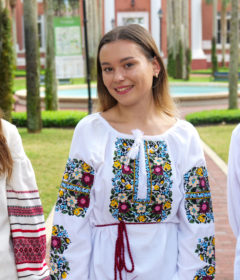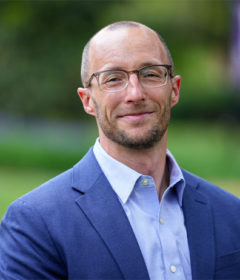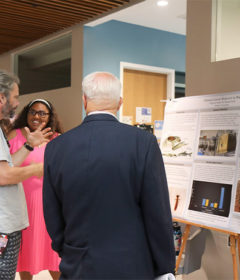Stetson profs bring new media art to Orlando Museum of Art
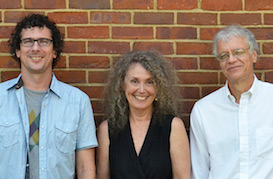
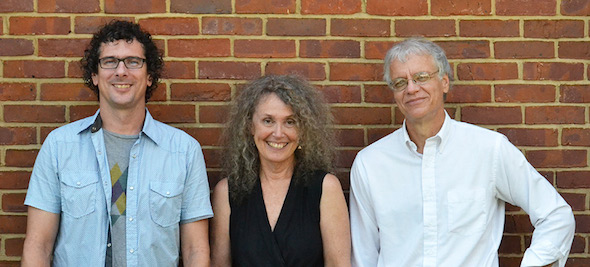
Stetson digital arts professor Matt Roberts has a fondness for “They Live,” a satirical 1988 sci-fi film by John Carpenter.
The flick tells the tale of a drifter who discovers magical glasses that enable him to see the startling truth: Society’s rulers are actually disguised aliens who manipulate people into spending money and accepting the status quo through subliminal messages in mass media.
A similar vibe, fueled by technology barely dreamed of in the 1980s, permeates several of Roberts’ artworks currently installed at the Orlando Museum of Art . . . well, it’s a similar vibe except for that alien manipulation part.
Roberts is one of 10 artists who was nominated for the 2016 Florida Prize in Contemporary Art, which is presented by the Orlando Museum of Art. According to an OMA press release, the prize, now in its third year, seeks to bring “a new level of recognition to the state’s most progressive artists.”
The concurrent exhibition, which runs through Aug. 14 at the museum, features Roberts and other artists who “work in a range of media and artistic practices, often in new and unexpected ways.” Tampa artist Noelle Mason was announced as this year’s winner of the prize during a reception held May 13.
“‘They Live’ is kind of a quirky movie, but I love this idea of putting on glasses and everything has a subtext to it,” Roberts said. “I like that idea of using technology to see what’s really there, or what else is also there, I should say.”
Two of Roberts’ works at OMA make use of “augmented reality” and “locative media.”
“Virtual reality is when you’re completely immersed into another ‘built’ world,” said Roberts, who more often calls himself a “new media artist” rather than a digital artist. “Virtual reality takes a lot of technology and it’s also very cumbersome. Augmented reality is like its half-brother. You’re laying the virtual on top of the real. What you see through your phone layers information on top of the real world.”
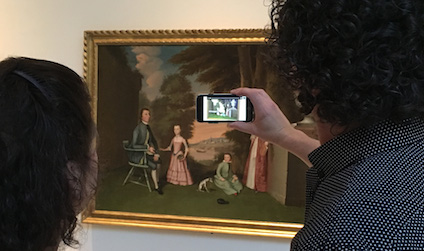
Locative media is “site specific,” Roberts said, meaning that an augmented reality artwork can be accessed by a smart phone only in a certain location.
Two of Roberts’ works in the Florida Prize in Contemporary Art exhibition are collaborations with fellow Stetson professors. For “The Strangers,” Roberts worked with poet Terri Witek, who holds the Sullivan Chair in Creative Writing and directs Stetson’s Sullivan Creative Writing Program. “Dream Garden” is a collaboration with Witek and computer science professor Michael Branton.
To experience “The Strangers,” museum-goers can download Layar, a free augmented reality app, on their smartphones, or use tablets at OMA. Hold your smartphone or tablet up to any of the nine paintings that are used in the project and you’ll see a visually altered painting and hear poetry created and read by Witek.
It’s a way to “get to unknow the collection,” says a description of the project on Roberts’ website, mattroberts.info. (In the large photo featured on the front page of Stetson Today, Roberts, left, shows a guest how to experience “The Strangers” using a tablet.)
That website also documents “Unknown Meetings,” another Roberts-Witek augmented reality project that has been set up along stops of the SunRail commuter train in Central Florida as well as in Glasgow, Scotland, and Vancouver, Canada. Hold up your smartphone in those places and you’ll see a flower blossom or a red teapot hovering ethereally in the midst of the real-life happenings there – sort of like a work by surrealist painter Rene Magritte come to life.
It was “Unknown Meetings” that prompted OMA curator Hansen Mulford to contact Roberts about doing a similar project at the Orlando museum.
“The Strangers” project “was so much fun,” Witek said. “You’re not a painter, but you’re activating the art. That was really fascinating to me. There’s a comforting, kind of controlled environment in a museum at times. I was very interested in re-inscribing these works to make them strangers, so you would have to see this collection differently.”
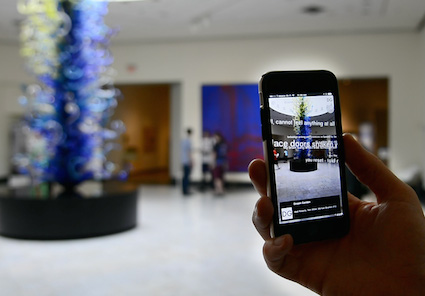
“Dream Garden” is an interactive project that “invites you to refurbish an urban space by activating a floating garden of 7-word dreams,” says the website inthedreamgarden.com.
Museum-goers or anyone can text a “7-word dream” – that is, a seven-word poetic sentence or phrase — to 904-337-9231. Again using the Layer app, those texted poems can be accessed by smartphones at site-specific locations, in this case the Orlando Museum of Art. Hold your phone up in the OMA’s Council of 101 Grand Gallery Hall and the 7-word dreams appear, seemingly floating in space.
“It’s like people are chasing fireflies with their phones,” Witek said of witnessing people stepping into the virtual garden.
“Dream Garden” uses software developed by Branton, professor of mathematics and computer science. Branton was one of four faculty members who designed and founded the computer science major at Stetson in 1983, and he founded the digital arts program at Stetson in 1995 and served as its first director.
“Dream Garden,” according to mattroberts.info, is intended “to gather, graft and nurture a city’s dreams. The project shows how some community resources – like citizens’ dreams — can inhabit and expand a space without wounding it, colonizing it or wasting natural resources. As a political space, it’s urban renewal and greening without displacement. As a philosophical space it suggests that dreaming together may change a city and even a country. As a community garden it suggests that our dreams aren’t wasted — they are growable, transplantable, and in the poetic space of the project, both virtual and real.”
“Waves,” another Roberts work at OMA, imports data from a National Weather Service wave buoy off Cape Canaveral. At the museum, technological devices translate that data into sound frequencies that vibrate a bowl of water, and the resulting ripples in the surface of the bowl’s water are projected onto the wall of the museum.
Are there traditionally-minded people who say digital art isn’t “real” art, that Roberts is a technologist rather than an artist?
“Oh yeah, all the time,” Roberts said. “You look at this exhibition and I’m the only artist who is using a computer as a tool. I’m looking at ‘What are our contemporary tools of communication and how can we use that for personal expression?’ I want to explore what are new languages in the way we express ourselves. How we can use those for creative expression beyond selling things?”
“I may have Oppositional Defiant Disorder, if somebody tells me I shouldn’t do something,” Witek said, tongue firmly in cheek. “People told me ‘Don’t do this! This can only ever be a hobby because poetry is for publication. You only have so long. You should publish in all the best journals.’ I did all that. I still make books.
“But why should any place be immune to poetry? I do projects for Facebook. The door is open, why not walk in?”
Roberts and Witek co-teach a course that is variously titled Advanced Open Studio (if students sign up on the humanities side) or Advanced Interdisciplinary Studio (if they sign up on the digital arts side). The course is for any student in the creatives arts: creative writing, theater, studio arts, digital arts. And, of course, interaction across genres and mediums is the norm.
“In my world there are a bunch of experimental poets who are working in multimedia ways,” Witek said. “I’m not afraid of what’s going to happen next partly because our students, as we’ve seen, don’t have any of these struggles. They are so there. So if they’re there, we can be there.”
The exhibition for the Florida Prize in Contemporary Art will run May 13-August 14, 2016, at the Orlando Museum of Art, 2416 North Mills Ave., Orlando. Museum hours are 10 a.m.-4 p.m. Tuesday through Friday and noon-4 p.m. Saturday and Sunday.
Admission is $10 adults, $7 ages 65 and older, $5 college students and children ages 4-17, free for ages 3 and younger. Information: 407-896-4231 or omart.org.
by Rick de Yampert

